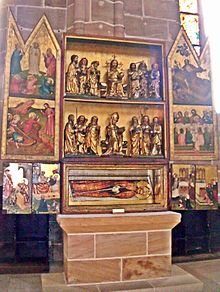Master of the Deokarus Altar
A Franconian carver who worked in Nuremberg in the Middle Ages is referred to as the master of the Deokarus altar ( also known as the master of the Deocarus altar in Latin spelling ) . The artist, who is not known by name, got his emergency name after the figures he carved in the 15th century for the altar of the holy abbot Deokarus in the church of St. Lorenz in Nuremberg. The Deokarus altar shows in the opened state in the middle part the enthroned Christ and Saint Deokarus, both surrounded by three standing apostles .
The wings of the altar, probably painted in a different workshop, depict scenes from the life of Christ and the resurrection. The predella underneath, also painted, shows scenes from the legend of Deokarus and a large picture of the reclining saint. Since the relics of Deokarus from Herrieden were transferred to the Lorenz Church in 1316, the honoring of the saint in the imperial city of Nuremberg had developed considerably, even if, despite Nuremberg's efforts, he was not formally canonized by Rome as a saint . The predella was probably intended to hold a reliquary vessel that has not survived today . A silver reliquary of St. Deokarus was donated for the church by Andreas and Margarete Volckamer in 1437. The donor couple is shown on the predella. It can be assumed that the entire altar was also completed as part of their foundation. However, there have also been assumptions that the carved figures were created earlier in 1406 and incorporated into the altar.
St. Lorenz became an Evangelical Lutheran church as early as 1529. However, the Deokarus Altar remained one of the many medieval works of art in Nuremberg that were not removed from their church during and after the Reformation . The altar is important for an understanding of the development of Nuremberg painting and carving and for an interpretation of the place of religious art and its craftsmen in medieval life.
The commissioned work of the master of the Deokarus altar as well as the altar of the master of the Imhoff altar that has been preserved in the same church and other altar foundations in Nuremberg, for example by the master of the Deichsler altar and the master of the Tucher altar, show together with the better known works of Veit Stoss in the city the importance that citizens ascribed to such foundations for honoring saints in the Middle Ages. Altars for cultivating relics were also an important point of attraction for pilgrims from the area up until the Reformation, as demonstrated by the making of a predella for the Deokarus altar to hold relics.
In the early days of art history, the exact identification of the name of the master carver of the Deokarus altar was discussed, today it is usually given less importance and the work of art itself and not the personality of this master is the focus of consideration of the altar.
literature
- Siegfried Graf Pückler-Limpurg : The Nuremberg art of painting at the turn of the 14th and 15th centuries . (Studies on German Art History, 48th issue) Heitz & Mündel, Strasbourg 1904, p.
- A. Fritsch: St. Lorenz: Stephanus, Laurentius, Deocarus. Church patrons and altar saints . Nuremberg 2001, DNB 963488724 , p.
Individual evidence
- ↑ z. B. Hartmut Boockmann : The city in the late Middle Ages . Beck, Munich 1986, ISBN 3-406-31565-8 , p. 212; z. B. also at AS Labuda: The "Resurrection of Christ" in the Krakow Marien Altar. On the problem of body and movement in the art of Veit Stoss . In: Artibus et Historiae Vol. 9, No. 18: 17-39 (1988) JSTOR 1483335 .
- ^ Wilhelm von Bode: History of German sculpture . Berlin undated (1887), p.
- ↑ s. A. Fritsch: St. Lorenz: Stephanus, Laurentius, Deocarus. Church patrons and altar saints . Nuremberg 2001
| personal data | |
|---|---|
| SURNAME | Master of the Deokarus Altar |
| BRIEF DESCRIPTION | German carver of the Middle Ages |
| DATE OF BIRTH | 14th century or 15th century |
| DATE OF DEATH | 15th century or 16th century |
